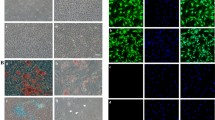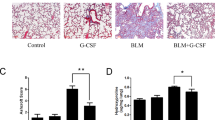Abstract
Bone marrow–derived stromal cells (BMSCs) protect against acute lung injury (ALI). To determine the role of BMSC mitochondria in this protection, we airway-instilled mice first with lipopolysaccharide (LPS) and then with either mouse BMSCs (mBMSCs) or human BMSCs (hBMSCs). Live optical studies revealed that the mBMSCs formed connexin 43 (Cx43)-containing gap junctional channels (GJCs) with the alveolar epithelia in these mice, releasing mitochondria-containing microvesicles that the epithelia engulfed. The presence of BMSC-derived mitochondria in the epithelia was evident optically, as well as by the presence of human mitochondrial DNA in mouse lungs instilled with hBMSCs. The mitochondrial transfer resulted in increased alveolar ATP concentrations. LPS-induced ALI, as indicated by alveolar leukocytosis and protein leak, inhibition of surfactant secretion and high mortality, was markedly abrogated by the instillation of wild-type mBMSCs but not of mutant, GJC-incompetent mBMSCs or mBMSCs with dysfunctional mitochondria. This is the first evidence, to our knowledge, that BMSCs protect against ALI by restituting alveolar bioenergetics through Cx43-dependent alveolar attachment and mitochondrial transfer.
This is a preview of subscription content, access via your institution
Access options
Subscribe to this journal
Receive 12 print issues and online access
$209.00 per year
only $17.42 per issue
Buy this article
- Purchase on Springer Link
- Instant access to full article PDF
Prices may be subject to local taxes which are calculated during checkout






Similar content being viewed by others
References
Prockop, D.J., Kota, D.J., Bazhanov, N. & Reger, R.L. Evolving paradigms for repair of tissues by adult stem/progenitor cells (MSCs). J. Cell Mol Med. 14, 2190–2199 (2010).
Parekkadan, B. & Milwid, J.M. Mesenchymal stem cells as therapeutics. Annu. Rev. Biomed. Eng. 12, 87–117 (2010).
Weiss, D.J., Kolls, J.K., Ortiz, L.A., Panoskaltsis-Mortari, A. & Prockop, D.J. Stem cells and cell therapies in lung biology and lung diseases. Proc. Am. Thorac. Soc. 5, 637–667 (2008).
Matthay, M.A., Goolaerts, A., Howard, J.P. & Lee, J.W. Mesenchymal stem cells for acute lung injury: preclinical evidence. Crit. Care Med. 38, S569–S573 (2010).
Rubenfeld, G.D. et al. Incidence and outcomes of acute lung injury. N. Engl. J. Med. 353, 1685–1693 (2005).
Krause, D.S. et al. Multi-organ, multi-lineage engraftment by a single bone marrow-derived stem cell. Cell 105, 369–377 (2001).
Ortiz, L.A. et al. Mesenchymal stem cell engraftment in lung is enhanced in response to bleomycin exposure and ameliorates its fibrotic effects. Proc. Natl. Acad. Sci. USA 100, 8407–8411 (2003).
Chang, J.C., Summer, R., Sun, X., Fitzsimmons, K. & Fine, A. Evidence that bone marrow cells do not contribute to the alveolar epithelium. Am. J. Respir. Cell Mol. Biol. 33, 335–342 (2005).
Kotton, D.N., Fabian, A.J. & Mulligan, R.C. Failure of bone marrow to reconstitute lung epithelium. Am. J. Respir. Cell Mol. Biol. 33, 328–334 (2005).
Lee, J.W., Fang, X., Gupta, N., Serikov, V. & Matthay, M.A. Allogeneic human mesenchymal stem cells for treatment of E. coli endotoxin-induced acute lung injury in the ex vivo perfused human lung. Proc. Natl. Acad. Sci. USA 106, 16357–16362 (2009).
Gupta, N. et al. Intrapulmonary delivery of bone marrow–derived mesenchymal stem cells improves survival and attenuates endotoxin-induced acute lung injury in mice. J. Immunol. 179, 1855–1863 (2007).
Curley, G.F. et al. Mesenchymal stem cells enhance recovery and repair following ventilator-induced lung injury in the rat. Thorax published online, doi:10.1136/thoraxjnl-2011-201059 (2011).
Mei, S.H. et al. Prevention of LPS-induced acute lung injury in mice by mesenchymal stem cells overexpressing angiopoietin 1. PLoS Med. 4, e269 (2007).
Xu, J. et al. Mesenchymal stem cell-based angiopoietin-1 gene therapy for acute lung injury induced by lipopolysaccharide in mice. J. Pathol. 214, 472–481 (2008).
Ortiz, L.A. et al. Interleukin 1 receptor antagonist mediates the antiinflammatory and antifibrotic effect of mesenchymal stem cells during lung injury. Proc. Natl. Acad. Sci. USA 104, 11002–11007 (2007).
Németh, K. et al. Bone marrow stromal cells attenuate sepsis via prostaglandin E(2)-dependent reprogramming of host macrophages to increase their interleukin-10 production. Nat. Med. 15, 42–49 (2009).
Dada, L.A. & Sznajder, J.I. Mitochondrial Ca2+ and ROS take center stage to orchestrate TNF-α–mediated inflammatory responses. J. Clin. Invest. 121, 1683–1685 (2011).
Harrois, A., Huet, O. & Duranteau, J. Alterations of mitochondrial function in sepsis and critical illness. Curr. Opin. Anaesthesiol. 22, 143–149 (2009).
Brealey, D. et al. Association between mitochondrial dysfunction and severity and outcome of septic shock. Lancet 360, 219–223 (2002).
Otsu, K. et al. Concentration-dependent inhibition of angiogenesis by mesenchymal stem cells. Blood 113, 4197–4205 (2009).
Spees, J.L., Olson, S.D., Whitney, M.J. & Prockop, D.J. Mitochondrial transfer between cells can rescue aerobic respiration. Proc. Natl. Acad. Sci. USA 103, 1283–1288 (2006).
Plotnikov, E.Y. et al. Cell-to-cell cross-talk between mesenchymal stem cells and cardiomyocytes in co-culture. J. Cell Mol Med. 12, 1622–1631 (2008).
Parthasarathi, K. et al. Connexin 43 mediates spread of Ca2+-dependent proinflammatory responses in lung capillaries. J. Clin. Invest. 116, 2193–2200 (2006).
Lindert, J., Perlman, C.E., Parthasarathi, K. & Bhattacharya, J. Chloride-dependent secretion of alveolar wall liquid determined by optical-sectioning microscopy. Am. J. Respir. Cell Mol. Biol. 36, 688–696 (2007).
Hawat, G., Benderdour, M., Rousseau, G. & Baroudi, G. Connexin 43 mimetic peptide Gap26 confers protection to intact heart against myocardial ischemia injury. Pflugers Arch. 460, 583–592 (2010).
Beahm, D.L. et al. Mutation of a conserved threonine in the third transmembrane helix of α- and β-connexins creates a dominant-negative closed gap junction channel. J. Biol. Chem. 281, 7994–8009 (2006).
Corti, M., Brody, A.R. & Harrison, J.H. Isolation and primary culture of murine alveolar type II cells. Am. J. Respir. Cell Mol. Biol. 14, 309–315 (1996).
Das Sarma, J. et al. Multimeric connexin interactions prior to the trans-Golgi network. J. Cell Sci. 114, 4013–4024 (2001).
Rustom, A., Saffrich, R., Markovic, I., Walther, P. & Gerdes, H.H. Nanotubular highways for intercellular organelle transport. Science 303, 1007–1010 (2004).
Rowlands, D.J. et al. Activation of TNFR1 ectodomain shedding by mitochondrial Ca2+ determines the severity of inflammation in mouse lung microvessels. J. Clin. Invest. 121, 1986–1999 (2011).
Macia, E. et al. Dynasore, a cell-permeable inhibitor of dynamin. Dev. Cell 10, 839–850 (2006).
Heller, A.R. et al. Adenosine A1 and A2 receptor agonists reduce endotoxin-induced cellular energy depletion and oedema formation in the lung. Eur. J. Anaesthesiol. 24, 258–266 (2007).
Kao, S.J., Liu, D.D., Su, C.F. & Chen, H.I. Niacinamide abrogates the organ dysfunction and acute lung injury caused by endotoxin. J. Cardiovasc. Pharmacol. 50, 333–342 (2007).
Guzy, R.D. et al. Mitochondrial complex III is required for hypoxia-induced ROS production and cellular oxygen sensing. Cell Metab. 1, 401–408 (2005).
Berg, J., Hung, Y.P. & Yellen, G. A genetically encoded fluorescent reporter of ATP:ADP ratio. Nat. Methods 6, 161–166 (2009).
Ashino, Y., Ying, X., Dobbs, L.G. & Bhattacharya, J. [Ca2+]i oscillations regulate type II cell exocytosis in the pulmonary alveolus. Am. J. Physiol. Lung Cell Mol. Physiol. 279, L5–L13 (2000).
Wang, P.M., Ashino, Y., Ichimura, H. & Bhattacharya, J. Rapid alveolar liquid removal by a novel convective mechanism. Am. J. Physiol. Lung Cell Mol. Physiol. 281, L1327–L1334 (2001).
Whitsett, J.A., Wert, S.E. & Weaver, T.E. Alveolar surfactant homeostasis and the pathogenesis of pulmonary disease. Annu. Rev. Med. 61, 105–119 (2010).
Dietl, P. & Haller, T. Exocytosis of lung surfactant: from the secretory vesicle to the air-liquid interface. Annu. Rev. Physiol. 67, 595–621 (2005).
Dominici, M. et al. Minimal criteria for defining multipotent mesenchymal stromal cells. The International Society for Cellular Therapy position statement. Cytotherapy 8, 315–317 (2006).
Acknowledgements
This study was supported by US National Institutes of Health grants HL64896, HL36024 and HL57556 to J.B. The authors thank G. Yellen (Harvard University) for the Perceval plasmid.
Author information
Authors and Affiliations
Contributions
M.N.I. carried out the experiments, prepared the figures and wrote the initial manuscript. S.R.D. carried out the protein gel assays. M.T.E. contributed to the flow cytometry experiments. M.W. carried out the RNA isolation and RT-PCR experiments. L.S. and S.K.Q. carried out the plasmid amplifications and BMSC transfections. K.W. contributed to the epithelial cell isolation experiments. D.J.R. contributed to the imaging experiments. S.B. contributed to the experimental design. J.B. was responsible for the overall project and wrote the initial manuscript. All authors edited the manuscript.
Corresponding author
Ethics declarations
Competing interests
The authors declare no competing financial interests.
Supplementary information
Supplementary Text and Figures
Supplementary Figures 1–6 and Supplementary Methods (PDF 5229 kb)
Rights and permissions
About this article
Cite this article
Islam, M., Das, S., Emin, M. et al. Mitochondrial transfer from bone-marrow–derived stromal cells to pulmonary alveoli protects against acute lung injury. Nat Med 18, 759–765 (2012). https://doi.org/10.1038/nm.2736
Received:
Accepted:
Published:
Issue Date:
DOI: https://doi.org/10.1038/nm.2736
This article is cited by
-
Mitochondria as secretory organelles and therapeutic cargos
Experimental & Molecular Medicine (2024)
-
Unraveling the complex roles of macrophages in obese adipose tissue: an overview
Frontiers of Medicine (2024)
-
Mitochondria in Mesenchymal Stem Cells: Key to Fate Determination and Therapeutic Potential
Stem Cell Reviews and Reports (2024)
-
The safety and efficacy of mesenchymal stromal cells in ARDS: a meta-analysis of randomized controlled trials
Critical Care (2023)
-
Extracellular vesicles derived from mesenchymal stem cells — a novel therapeutic tool in infectious diseases
Inflammation and Regeneration (2023)



